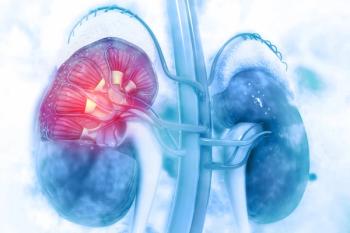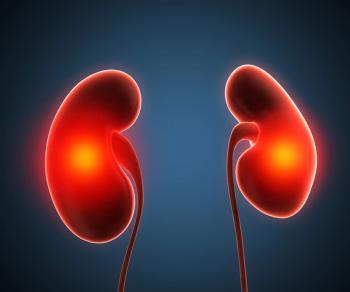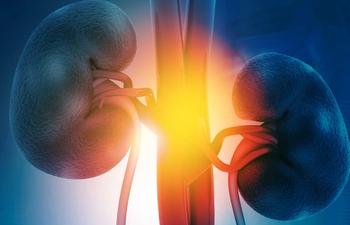
Oncology NEWS International
- Oncology NEWS International Vol 10 No 10
- Volume 10
- Issue 10
High-Dose IL-2 Is Standard in Advanced Renal Cell Cancer
SAN FRANCISCO-Trials employing outpatient use of subcutaneous (SC) interleukin-2 (IL-2, Proleukin) in lower doses suggest that the overall response rate in metastatic renal cell carcinoma is adversely affected by the decrease in dose or the subcutaneous route of administration.
SAN FRANCISCOTrials employing outpatient use of subcutaneous (SC) interleukin-2 (IL-2, Proleukin) in lower doses suggest that the overall response rate in metastatic renal cell carcinoma is adversely affected by the decrease in dose or the subcutaneous route of administration.
In a preliminary analysis of phase III data comparing the best high-dose treatment (IL-2 alone) with the best outpatient regimen (IL-2/interferon-alfa [IFN-alfa-2b, Intron A]) for metastatic disease, researchers from the Cytokine Working Group reported a trend toward improved responses in patients assigned to the high-dose regimen.
David McDermott, MD, of Deaconess Medical Center, Boston, presented the study at the 37th Annual Meeting of the American Society of Clinical Oncology (ASCO abstract 685).
Interleukin-2 is a cytokine that is thought to exert its major antitumor effect through lymphocyte activation. High-dose IL-2 was FDA-approved in 1992; currently, it is the only approved treatment for patients with metastatic kidney cancer.
Previous studies of IL-2 indicated durable high-quality responses in approximately 10% of patients with renal cell carcinoma. Use of the cytokine, however, sometimes produces life-threatening toxicities. Large bolus doses of IL-2 are associated with the capillary leak syndrome and require vigilant inpatient monitoring. High-dose IL-2 should be administered at a facility where the staff is experienced in dealing with the toxicities of this agent.
Various studies have attempted different doses and alternate routes to mitigate its significant toxicities. Tests of subcutaneous IL-2 therapy in the clinic looked promising.
Dr. McDermott cited sequential phase II studies published in the Cancer Journal of Scientific American in 1997 that found a similar response rate (ranging from 11% to 17%) and median survival (15 to 20 months) for low-dose outpatient IL-2/IFN. This is significant because of the expense and inconvenience of intravenous dosing compared with subcutaneous doses self-administered at home.
Acute toxicity also was less with the low-dose outpatient treatments. However, there appeared to be improvement in 3-year progression-free survival and median response duration with use of high-dose IL-2.
Phase III Trial
Before accepting low-dose regimens as standard therapy, the Cytokine Working Group conducted the current phase III trial. The study enrolled 193 patients aged 21 to 75 years (median, 54) with good performance status (ECOG 0/1). Importantly, patients could not have received prior biologic therapy.
Patients were stratified for bone and liver metastases, primary tumor in place, and performance status. Treatment arms were balanced for these characteristics. Overall, 25% of patients had primary tumor in place; 19% and 32% had liver and bone metastases, respectively.
Patients were randomly assigned to receive 4 weeks of outpatient treatment with low-dose IL-2 (5 mIU/m² SC, every 8 hours on day 1 then daily 5 days a week for 4 weeks) plus IFN-alfa-2b (5 mIU/m² SC, three times a week for 4 weeks) every 6 weeks, or high-dose IL-2 (600,000 IU/kg/dose IV every 8 hours on days 1-5 and 15-19 for a maximum of 28 doses) every 12 weeks.
Tumor responses were assessed at weeks 6 and 12, then every 12 weeks. Responding patients on IL-2/IFN received up to six cycles, and those on high-dose IL-2 received up to three cycles.
The trial demonstrated a twofold improvement in response rate for high-dose IL-2 (25% vs 11% on low-dose IL-2/INF). There was also a significant improvement in quality of response, with eight complete responses (8%) on high-dose IL-2 vs two complete responses (2%) on the low-dose arm. The median response durations are 16 months for high-dose IL-2 vs 13 months for the low-dose regimen.
There were more grade 3-4 toxicities in the high-dose IL-2 group, Dr. McDermott said. Toxicities seen are typical for these regimens, and most were reversible. One treatment-related death from capillary leak syndrome occurred after 10 doses of high-dose IL-2, and there was one on the low-dose arm as well.
Median survival is 15 months for high-dose IL-2 alone and 12 months for IL-2/IFN. Dr. McDermott cautioned that the data are preliminary (median follow-up ranges from 9 to 48 months), and the primary endpoint of 3-year progression-free survival has yet to be reached.
He concluded that, at this early analysis, high-dose IL-2 should remain the preferred therapy for appropriately selected patients. It is too early to determine if there will be a significant increase in median survival.
Articles in this issue
about 24 years ago
RIT Safe, Effective in Elderly and Poor-Prognosis Patientsabout 24 years ago
FDA Approves Xeloda/Taxotere Combination for Advanced Breast Cancerabout 24 years ago
ODAC Recommends Approval of Radiolabeled Zevalinabout 24 years ago
Proteomics Moves From the Laboratory to Clinical Researchabout 24 years ago
Radiotherapy Not Needed in Older Lumpectomy Patients With Early Cancerabout 24 years ago
Raltitrexed + Oxaliplatin for Advanced Colorectal Cancerabout 24 years ago
Mental Fatigue Worries Chemotherapy Patientsabout 24 years ago
Patients Urged to Work With Professionals Against Fatigueabout 24 years ago
NCI Director Resigns to Head New Scientific Instituteabout 24 years ago
Combined PET/CT Aids in Head and Neck Cancer ManagementNewsletter
Stay up to date on recent advances in the multidisciplinary approach to cancer.


















































































